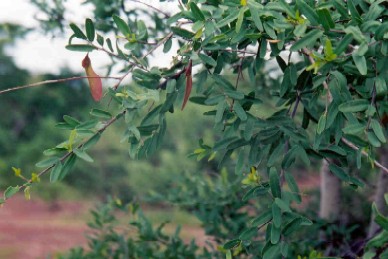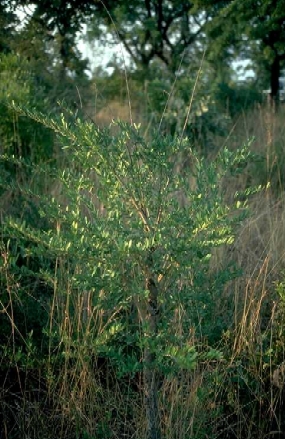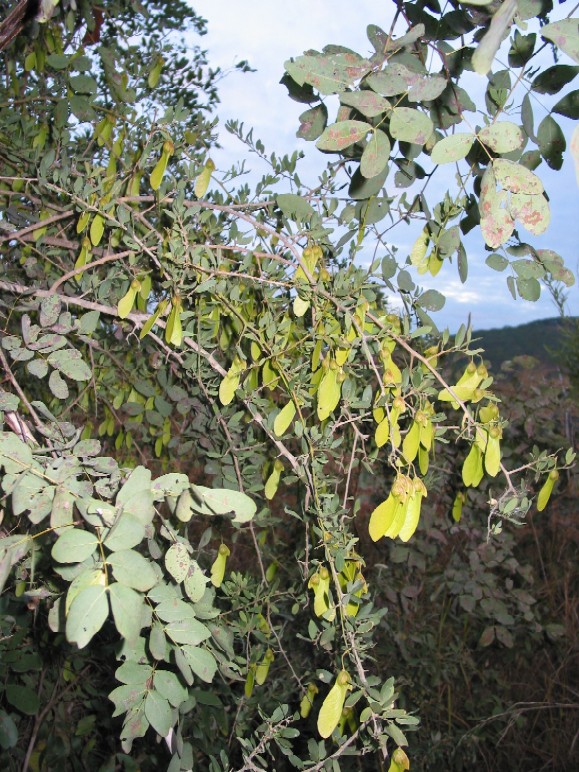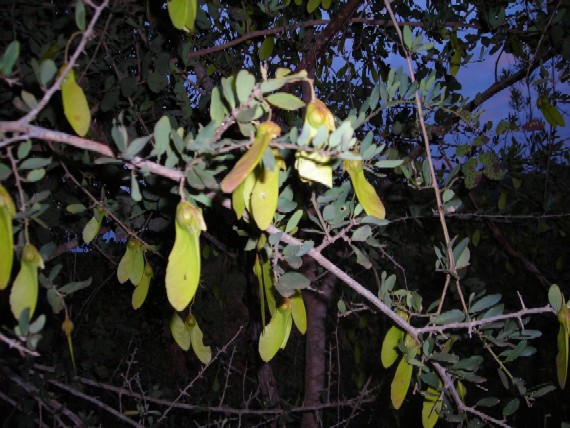Securidaca longepedunculata
Fact sheet about Securidaca longepedunculata
Distribution and habitat
Securidaca longepedunculata grows in varying climatic conditions, from hot arid to humid climates and in broad vegetation range, from semi-arid to dense forest. It is common in sub-Saharan Africa in Savannah and Sahel environments. In Kenya, it can be found in Makueni and Kwale.
Flowering and fruiting habits
It is a small tree up to 6m in height, sometimes spiny and pale grey, smooth bark. Stems are initially pubescent, then glaborous. Leaves vary in size and shape, alternate, commonly in clusters. Flowers are sweetly scented, purple pink, about 1cm in length and in bunches, borne on a long slim stalk. Fruit is round nut bearing a membranous wing about 4 cm long, purple when young, beige when mature. Flowers are produced in March-April in Kenya. When in flower, it attracts birds, butterflies and other insects. Fruits appear in May in Kenya and hang on trees for many months.
Uses other than pesticidal
Medicinal - Violet tree is a most popular traditional medicinal plant in many African countries. Powdered roots and bark or infusions are traditionally used to treat headache, stomach and chest problems, inflammation, tuberculosis, venereal diseases, constipation, toothache among others. It is reported to have antimicrobial activities against protozoa, bacteria and fungi. The active compound securinine has activity against malaria causative agent Plasmodium falciparum. Xanthone compounds from the root bark confer action against erectile dysfunction.
Soap – The bark is used for soap.
Fibre – The strong and durable fibres from the inner bark are used for fishing nets, baskets, bark cloth and strong threads.
Food – Young leaves are used as vegetables and in sauces. Root infusions with maize or sorghum used as a beverage.
Fodder – Animals feed on the roots
Apiculture – The flowers are frequented by bees for honey production.
Propagation and cultivation
Propagation is done by seeds, best collected when mature. Seeds are recalcitrant, thus need processing as soon as collected. Seed coat removed with a scalpel, seeds best sown in cocopeat or vermiculite or forest soil. Transplant to a media of sand:soil in polythene bags for growth.
Root cuttings are also used for propagation.
Seed collection & Storage
Harvesting of seeds is done by hand, best when seeds are mature. Seeds are released from seed coat using a scalpel.
Seeds are recalcitrant and thus cannot be stored for a long time.
Parts used
Root bark
Preparation
Dry and grind
Uses
Can be used both pre and post-harvest
Target organisms
Against broad range of insects
Small tree up to about 6 m. or shrub, sometimes spiny; stems usually pubescent at first, becoming glabrous. Leaves petiolate; lamina 1–5 x 0.5–1.8 cm., very variable in size and shape, from broadly oblong to very narrowly elliptic, usually minutely pubescent when young, soon becoming glabrous; petiole up to 5 mm. long. Flowers pink or purple sometimes variegated with white, sweet-scented, pedicels up to 14 mm. long, pubescent, in terminal or lateral racemes, 3–5 cm. long, often borne on short shoots which become spiny, with minute, deciduous bracts and bracteoles and pubescent rhachis. Posterior sepal up to 5 x 4 mm. ovate-acuminate, with ciliate margins; wing sepals 5–11 x 4–9 mm., suborbicular, nearly glabrous; anterior sepals up to 5 x 4.5 mm., broadly ovate. Upper petals up to 7.5 x 3.5 mm., narrowly elliptic, ciliate at the base; carina up to 10 mm. long with a small lobed appendage about 1 mm. long near the apex. Staminal sheath ciliate on the upper margin. Fruit 3–5 x 0.8–2 cm., with an oblong or elliptic somewhat obliquely curved wing, sometimes with a second rudimentary wing. Nut containing the seed 8–10 mm. in diam., rugulose or smooth.
Found in various types of woodland and wooded grassland across sub-Saharan Africa. It's rarely gregarious and a very variable species in leaf-shape and flower-size as well as in habit and extent to which spines develop. It has been subdivided by various authors into a number of varieties. Specimens from Mozambique coastal regions tend to have longer, narrower leaves, while some of the smallest and roundest leaves occur on specimens from Angola. There is, however, great variation in most parts of the range.This is known as the Violet Tree owing to the scent of the flowers. The bast produces a useful fibre which the Africans use as cotton and from which they used to weave a coarse cloth. An infusion of the roots is used as a remedy for snake-bite and also as a poison
Plant parts with insect-controlling properties
roots, root bark, stem bark
Mode of action
stomach poison, anti-convulsant, purgative, repellent, toxic, anti-inflammatory, anti-fertility
Target organisms
used as a fish poison, various medicinal treatments, as a molluscicide, insecticide, particularly stored product protection
Preparation and application
Whole roots (i.e. lateral branches) are dug up without uprooting the entire plant. Only a few roots can be taken from each plant. The roots are then dried in the shade for a few days. The bark is either stripped and pounded or the entire root is pounded. This is then admixed with stored grain. Alternatively the pounded roots are soaked in water overnight and the water extract is used as a grain dip.






